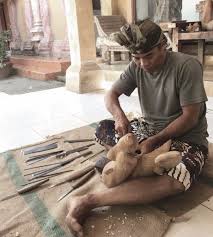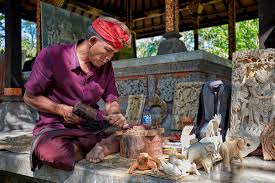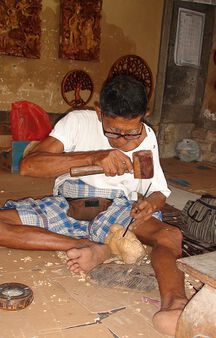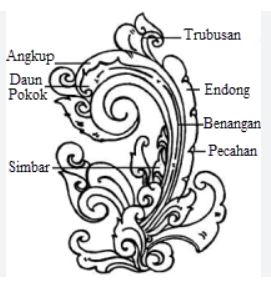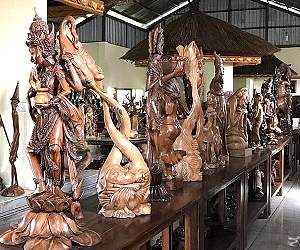Wood Carvings: Difference between revisions
(Created page with "My name is Manuel and I am studying Directing and Neuroscience at St Levan / Great Britain.<br><br>Also visit my web-site Kometa web casino ([https://game-ss.ru/ game-ss.ru]) ") |
No edit summary |
||
| (8 intermediate revisions by the same user not shown) | |||
| Line 1: | Line 1: | ||
{{ | {{PAGEBANNER01}} | ||
'''Wood Carvings Content'''<br> | '''Wood Carvings Content'''<br> | ||
[[Wood Carvings * Statues|Statues]] - [[Wood Carvings * Masks|Masks]] - [[Wood Carvings * Faces|Faces]] - [[Wood Carvings * Busts|Busts]] - [[Wood Carvings * Panels|Panels]] - [[Wood Carvings * Plaques|Plaques]] - [[Wood Carvings * Other Wood Carvings|Other Wood Carvings]]<br> | [[Wood Carvings * Statues|Statues]] - [[Wood Carvings * Masks|Masks]] - [[Wood Carvings * Faces|Faces]] - [[Wood Carvings * Busts|Busts]] - [[Wood Carvings * Panels|Panels]] - [[Wood Carvings * Plaques|Plaques]] - [[Wood Carvings * Other Wood Carvings|Other Wood Carvings]]<br> | ||
| Line 5: | Line 5: | ||
[[File:Woodcarver 01.jpg|right|244x244px]] | [[File:Woodcarver 01.jpg|right|244x244px]] | ||
== Wood Carving in Indonesia == | == Wood Carving in Indonesia == | ||
Woodcarving is the most enduring and widespread medium for artistic expression in Indonesia. Each Culture has its own style, and the diversity and | Woodcarving is the most enduring and widespread medium for artistic expression in Indonesia. Each Culture has its own style, and the diversity and sophistication of Indonesia’s woodcarvers is remarkable. In Indonesia a house not only protects its inhabitants from the elements, but repels unwanted spirits. Example include the horned Singa (lion) heads that protect Batak Houses, the water buffalo representations on toraja houses sigifying prosperity, or the serpents and magical dog carving on Dayak houses in Kalimantan.<p> | ||
Objects made of wood can have spiritual, artistic and functional purposes or elements of all three. Some of the more lovely functional objects are ironwood stools from Kalimantan, carved bamboo containers from Sulawesi and doors from Timor. Perhaps the most famous artistic and spiritual carvings are masks. They are associated most with the masked dance-dramas of Java and Bali but are also used in dances and funeral rites and ceremonies on other islands.<p> | Objects made of wood can have spiritual, artistic and functional purposes or elements of all three. Some of the more lovely functional objects are ironwood stools from Kalimantan, carved bamboo containers from Sulawesi and doors from Timor. Perhaps the most famous artistic and spiritual carvings are masks. They are associated most with the masked dance-dramas of Java and Bali but are also used in dances and funeral rites and ceremonies on other islands.<p> | ||
| Line 14: | Line 14: | ||
'''Bali Wood Carving History''' | '''Bali Wood Carving History''' | ||
The rise of Balinese wood carving can be traced back hundreds of years ago to the time when Hindu-Javanese preachment was set in motion. In the beginning wood carvings in Bali functioned as a mode of expression for carrying out religious ceremonies, and primarily the use of carvings was limited only inside the temples and palaces. This set of circumstances passed along until the twentieth century. Back in those days, ornamental frames, ornate doorways, statues of gods and deities, and masks were made for the sole purpose of paying homage. Very often they were symbolized as objects of guardianship. Besides, it was not an uncommon phenomenon to find wooden panels and sculptures of the time as interior decoration pieces. The art of Balinese woodcarving had its beginnings around the twelfth century. Formerly, local carvers used the stone as the sole material to form carvings. It was not within the bounds of possibility for them to carve wood beforehand as this form of art required a higher level of skill and precision. This can be seen from the finish on the wood carving which looks more polished than the other types of carving. The aesthetics that were of interest to the people at that time were a blend of Buddhist and Hindu influences. However, the impact of Buddhist preaching slowly waned when Majapahit conquered Bali in the thirteenth century. The traditional Hindu teachings that were brought about certainly shifted the influence of Buddhism, which automatically affected traditions that had previously taken root in various aspects of Balinese life, including the emergence of new rules that restricted sculptors from creating only god and human figures in their artwork. Until then, the general public purely considered the sculptures and paintings they created as a means of worshipping alone. However, a shift in mindset on a large scale in the Balinese art world emerged in the early twentieth century.<p> | The rise of Balinese wood carving can be traced back hundreds of years ago to the time when Hindu-Javanese preachment was set in motion. In the beginning wood carvings in Bali functioned as a mode of expression for carrying out religious ceremonies, and primarily the use of carvings was limited only inside the temples and palaces. This set of circumstances passed along until the twentieth century. Back in those days, ornamental frames, ornate doorways, statues of gods and deities, and masks were made for the sole purpose of paying homage. Very often they were symbolized as objects of guardianship. Besides, it was not an uncommon phenomenon to find wooden panels and sculptures of the time as interior decoration pieces. The art of Balinese woodcarving had its beginnings around the twelfth century. Formerly, local carvers used the stone as the sole material to form carvings. It was not within the bounds of possibility for them to carve wood beforehand as this form of art required a higher level of skill and precision. This can be seen from the finish on the wood carving which looks more polished than the other types of carving. The aesthetics that were of interest to the people at that time were a blend of Buddhist and Hindu influences. However, the impact of Buddhist preaching slowly waned when Majapahit conquered Bali in the thirteenth century. The traditional Hindu teachings that were brought about certainly shifted the influence of Buddhism, which automatically affected traditions that had previously taken root in various aspects of Balinese life, including the emergence of new rules that restricted sculptors from creating only god and human figures in their artwork. Until then, the general public purely considered the sculptures and paintings they created as a means of worshipping alone. However, a shift in mindset on a large scale in the Balinese art world emerged in the early twentieth century.<p> | ||
[[File:woodcarver 03.jpg|thumb | [[File:woodcarver 03.jpg|thumb|338x338px|''A woodcarver in Ubud'']] | ||
Dutch traders felt the potential to put up carvings made by local Balinese artisans for sale in the international market. There was a great demand for Balinese wood carvings generally in Europe which even convinced some Western artists to settle in Bali and start over their careers there. Some of the leading artists who have been noted living in Bali due to the wide-ranging frenzy of Balinese wood carving include Jaap Kunst, Rudolf Bonnet, and Walter Spies. Ubud and the surrounding villages became the most prominent art center in Bali at that time, thanks to the growing popularity of Balinese wood carving in the international market. Several Western artists who have been previously mentioned were known to providing assistance and initiating the reconstruction movement of Balinese carvings and paintings which had previously been corrupted by the Dutch invasion of the island. The Dutch occupied Bali for two years since 1906, and because of this, the ingrained tradition of long-established art-making was eroded. Balinese craftsmen are required to labor their full ability entirely to produce commercial goods rather than objects for religious purposes. This ultimately influenced the choice of subjects that appeared in the sculptures marketed after World War II ended when Bali was liberated from Dutch colonialism. Rudolf Bonnet and Walter Spies strived to guide Balinese craftsmen on how they could promote their lines of work to the European market. This movement later inspired other local craftsmen to develop fresh carving techniques and styles. To this day, local craftsmen can continue to produce stunning Balinese wood carvings for a variety of purposes without being constrained by restrictive rules or limitations. You can observe this from the use of statues for religious ceremonies, wall hangings as interior decoration, to other marketing purposes on a daily basis.<p> | Dutch traders felt the potential to put up carvings made by local Balinese artisans for sale in the international market. There was a great demand for Balinese wood carvings generally in Europe which even convinced some Western artists to settle in Bali and start over their careers there. Some of the leading artists who have been noted living in Bali due to the wide-ranging frenzy of Balinese wood carving include Jaap Kunst, Rudolf Bonnet, and Walter Spies. Ubud and the surrounding villages became the most prominent art center in Bali at that time, thanks to the growing popularity of Balinese wood carving in the international market. Several Western artists who have been previously mentioned were known to providing assistance and initiating the reconstruction movement of Balinese carvings and paintings which had previously been corrupted by the Dutch invasion of the island. The Dutch occupied Bali for two years since 1906, and because of this, the ingrained tradition of long-established art-making was eroded. Balinese craftsmen are required to labor their full ability entirely to produce commercial goods rather than objects for religious purposes. This ultimately influenced the choice of subjects that appeared in the sculptures marketed after World War II ended when Bali was liberated from Dutch colonialism. Rudolf Bonnet and Walter Spies strived to guide Balinese craftsmen on how they could promote their lines of work to the European market. This movement later inspired other local craftsmen to develop fresh carving techniques and styles. To this day, local craftsmen can continue to produce stunning Balinese wood carvings for a variety of purposes without being constrained by restrictive rules or limitations. You can observe this from the use of statues for religious ceremonies, wall hangings as interior decoration, to other marketing purposes on a daily basis.<p> | ||
| Line 35: | Line 35: | ||
Looking for the best place to shop for wood carvings in Bali? Then you shouldn’t miss visiting the villages of Mas on your trip. Visiting this place on your travel to or from Ubud is certainly ‘one from’. The villages of Mas is one of the tourist objects in the Ubud area of Bali which is a place for sculpture craftsmen, always an alternative stopover when tourists are on a tour to Ubud or Kintamani tourist attractions. The expertise of local people in inheriting the culture of their ancestors who worked as sculptors has made it even more famous along with the development of tourism in Bali. With the skyrocketing popularity of Balinese wood carving, the sales of art in the village were able to boost the economy of the local community. The fame of this village cannot be separated from the great names of some of the exceptional sculpture craftsmen who were born, raised, and who have talent in creating wood sculptures and started their career there. The villages of Mas are strategically located, about 20 km from Denpasar. It is not surprising, as a center for wood carving art in Bali, that many craft shops are selling a multitude of sculptures and carvings.<br> | Looking for the best place to shop for wood carvings in Bali? Then you shouldn’t miss visiting the villages of Mas on your trip. Visiting this place on your travel to or from Ubud is certainly ‘one from’. The villages of Mas is one of the tourist objects in the Ubud area of Bali which is a place for sculpture craftsmen, always an alternative stopover when tourists are on a tour to Ubud or Kintamani tourist attractions. The expertise of local people in inheriting the culture of their ancestors who worked as sculptors has made it even more famous along with the development of tourism in Bali. With the skyrocketing popularity of Balinese wood carving, the sales of art in the village were able to boost the economy of the local community. The fame of this village cannot be separated from the great names of some of the exceptional sculpture craftsmen who were born, raised, and who have talent in creating wood sculptures and started their career there. The villages of Mas are strategically located, about 20 km from Denpasar. It is not surprising, as a center for wood carving art in Bali, that many craft shops are selling a multitude of sculptures and carvings.<br> | ||
---- | ---- | ||
'''More info''' | '''More info:'''<br> | ||
[https://dejepara.com/blog/history-of-jepara-the-world-carving-city History of Jepara - The world carving city]<br> | |||
[https://www.wiki-indonesian-art.com/video/bali%20wood%20carving%20artists.htm Video 1: Bali Wood Carving Artists]<br> | |||
[https://wiki-indonesian-art.com/video/balinese%20traditional%20handicrafts.htm Video 2: Balinese traditional handicrafts] | |||
[[Category:Main | [[Category:Article message templates]] | ||
[[Category:Wood Carvings02]] | |||
[[Category:Main Page02]] | |||
Latest revision as of 17:09, 29 October 2024
 Wood Carvings Content
Wood Carvings Content
Statues - Masks - Faces - Busts - Panels - Plaques - Other Wood Carvings
Wood Carving in Indonesia
Woodcarving is the most enduring and widespread medium for artistic expression in Indonesia. Each Culture has its own style, and the diversity and sophistication of Indonesia’s woodcarvers is remarkable. In Indonesia a house not only protects its inhabitants from the elements, but repels unwanted spirits. Example include the horned Singa (lion) heads that protect Batak Houses, the water buffalo representations on toraja houses sigifying prosperity, or the serpents and magical dog carving on Dayak houses in Kalimantan.
Objects made of wood can have spiritual, artistic and functional purposes or elements of all three. Some of the more lovely functional objects are ironwood stools from Kalimantan, carved bamboo containers from Sulawesi and doors from Timor. Perhaps the most famous artistic and spiritual carvings are masks. They are associated most with the masked dance-dramas of Java and Bali but are also used in dances and funeral rites and ceremonies on other islands.
Used in prehistoric times in burials, the use of ancient spirit masks have given way to masks used in many traditional dances. These highly stylized masks, topeng, depict the various characters in the story told by the dance. Masks enable the performers to assume new identities and depict a variety of characters from demons to animals, princes or gods. Amongst the most famous masks used in dance are the Rangda and Barong masks from Bali. In this traditional dance, performed often for tourists, the interaction of Rangda, representing evil, and the Barong, representing good, restores the harmony between the good and evil in life. While masks for sale in stores are primarily from Central Java and Bali, masks from other ethnic groups were used widely in the past to communicate with ancestors, for blessings for harvests, protection from evil spirits, to acquire new personalities or great powers.
Bali Wood Carving History
The rise of Balinese wood carving can be traced back hundreds of years ago to the time when Hindu-Javanese preachment was set in motion. In the beginning wood carvings in Bali functioned as a mode of expression for carrying out religious ceremonies, and primarily the use of carvings was limited only inside the temples and palaces. This set of circumstances passed along until the twentieth century. Back in those days, ornamental frames, ornate doorways, statues of gods and deities, and masks were made for the sole purpose of paying homage. Very often they were symbolized as objects of guardianship. Besides, it was not an uncommon phenomenon to find wooden panels and sculptures of the time as interior decoration pieces. The art of Balinese woodcarving had its beginnings around the twelfth century. Formerly, local carvers used the stone as the sole material to form carvings. It was not within the bounds of possibility for them to carve wood beforehand as this form of art required a higher level of skill and precision. This can be seen from the finish on the wood carving which looks more polished than the other types of carving. The aesthetics that were of interest to the people at that time were a blend of Buddhist and Hindu influences. However, the impact of Buddhist preaching slowly waned when Majapahit conquered Bali in the thirteenth century. The traditional Hindu teachings that were brought about certainly shifted the influence of Buddhism, which automatically affected traditions that had previously taken root in various aspects of Balinese life, including the emergence of new rules that restricted sculptors from creating only god and human figures in their artwork. Until then, the general public purely considered the sculptures and paintings they created as a means of worshipping alone. However, a shift in mindset on a large scale in the Balinese art world emerged in the early twentieth century.
Dutch traders felt the potential to put up carvings made by local Balinese artisans for sale in the international market. There was a great demand for Balinese wood carvings generally in Europe which even convinced some Western artists to settle in Bali and start over their careers there. Some of the leading artists who have been noted living in Bali due to the wide-ranging frenzy of Balinese wood carving include Jaap Kunst, Rudolf Bonnet, and Walter Spies. Ubud and the surrounding villages became the most prominent art center in Bali at that time, thanks to the growing popularity of Balinese wood carving in the international market. Several Western artists who have been previously mentioned were known to providing assistance and initiating the reconstruction movement of Balinese carvings and paintings which had previously been corrupted by the Dutch invasion of the island. The Dutch occupied Bali for two years since 1906, and because of this, the ingrained tradition of long-established art-making was eroded. Balinese craftsmen are required to labor their full ability entirely to produce commercial goods rather than objects for religious purposes. This ultimately influenced the choice of subjects that appeared in the sculptures marketed after World War II ended when Bali was liberated from Dutch colonialism. Rudolf Bonnet and Walter Spies strived to guide Balinese craftsmen on how they could promote their lines of work to the European market. This movement later inspired other local craftsmen to develop fresh carving techniques and styles. To this day, local craftsmen can continue to produce stunning Balinese wood carvings for a variety of purposes without being constrained by restrictive rules or limitations. You can observe this from the use of statues for religious ceremonies, wall hangings as interior decoration, to other marketing purposes on a daily basis.
What wood is used for Balinese carvings?
In Bali, many different types of wood are used for carving. Some examples include teak, crocodile wood, acasia, sonokeling (rose wood), macassar ebony, palissander, suar, jackfruit, shorea (meranti), mirabouw, panggal buaya, mahogany or sandalwood.
Balinese Wood Carving Characteristics
Balinese carving products have their distinctive motifs. These motifs are relics of ancient kingdoms that have experienced advances in the world of arts. The motifs are recognized by several distinctive features that are divided between general and specific characteristics. The general characteristic is that Balinese wood carvings have convex and concave motifs of leaves, flowers, and fruits.
The special characteristics of Balinese wood carving include:
“Angkup” on Balinese motifs, as in other motifs, has a shape that is curved at the ends. The shape of a “sunggar” that grows from the end of the thread curl on the main leaf. The “simbar” in Balinese motifs are similar to those found in the typical Pelajaran and Majapahit motifs. Simbar is usually found in front of the base of the main leaf following the shape of the groove so that it can form an overall harmony to the overall form. The thread on this motif has a special shape. The threads are convex and partially slanted. This thread grows in a circle up to the end of the curl and has broken lines that run on the main leaf and “cawen” fragments found in the carvings of the patran leaves. All of this adds to the harmony and beauty to the shape of the carving. The uniqueness of Balinese carvings has been able to attract buyers for the last few years, both local and foreign, which has led to many people who have also worked as carvers for their work. It is not surprising then that several Balinese carving centers can easily be found on the island. For example, villages of Mas (Ubud), Tangep (Mengwi), Peken Belayu, Marga (Tabanan), and many other villages, which are famous as Balinese carving centers.
Pros and Cons of Balinese Wood Carving
Apart from being merely an artwork, Balinese wood carvings demonstrate many amazing things about this particular form of art. However, if we were asked to mention the best thing about Balinese art, it is that each piece is designed with great care to enhance the use-value of other menial objects that we use almost every day. Therefore, it is not only Bali-based goods that you purchase for embellishment purposes that you can admire for its splendor. But they are also items of high use value that can be gouged nearly anytime and anywhere, although we must emphasize that they are too good to wear on regular occasions if truth be told. However, it can take a long time to work on a piece of Balinese wood carving. This is due to the complexity of the patterns implemented. Besides, the raw materials commonly have to be imported from afar, which often takes days for them to set in. The raw materials for the manufacture are teak, moja gaung, and chrysolite. However, because these artisans cannot acquire the wood from Bali, usually they have to order it from Kalimantan, Sumba, or Flores. You have to be extra patient before you can take these beautiful souvenirs home and display them in your home.
Another valuable piece of advice in hunting for the perfect wood carving is that you also have to be observant when you shop for it. Not all craftsmen use the same raw materials in producing their wood carvings. If the materials used are of low quality, it will result in unsatisfactory art, such as wood carving that cracks when it reaches other parts of the world with a different humidity level or temperature than the place of origin where the craft was produced. A rule of thumb: You shouldn’t splurge on buying a carving that’s prone to cracks if you’re not ready to leave it. In most cases, woods of several types can easily crack due to extreme differences in settings.
Best Place in Bali to Shop for Wood Carvings
Looking for the best place to shop for wood carvings in Bali? Then you shouldn’t miss visiting the villages of Mas on your trip. Visiting this place on your travel to or from Ubud is certainly ‘one from’. The villages of Mas is one of the tourist objects in the Ubud area of Bali which is a place for sculpture craftsmen, always an alternative stopover when tourists are on a tour to Ubud or Kintamani tourist attractions. The expertise of local people in inheriting the culture of their ancestors who worked as sculptors has made it even more famous along with the development of tourism in Bali. With the skyrocketing popularity of Balinese wood carving, the sales of art in the village were able to boost the economy of the local community. The fame of this village cannot be separated from the great names of some of the exceptional sculpture craftsmen who were born, raised, and who have talent in creating wood sculptures and started their career there. The villages of Mas are strategically located, about 20 km from Denpasar. It is not surprising, as a center for wood carving art in Bali, that many craft shops are selling a multitude of sculptures and carvings.
More info:
History of Jepara - The world carving city
Video 1: Bali Wood Carving Artists
Video 2: Balinese traditional handicrafts
